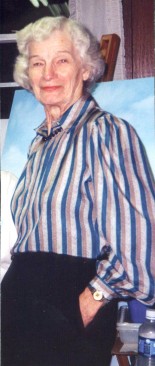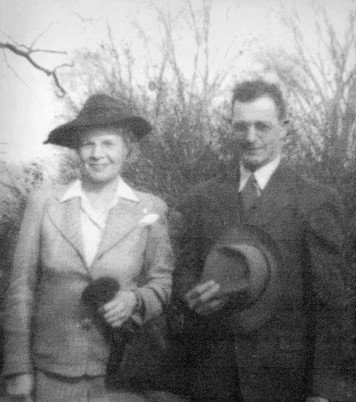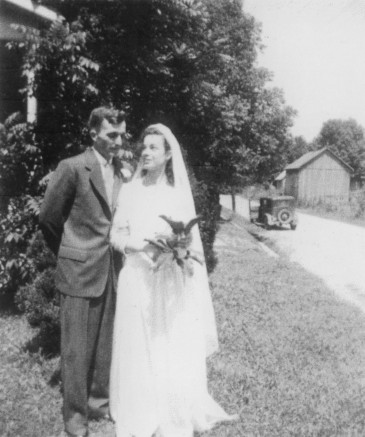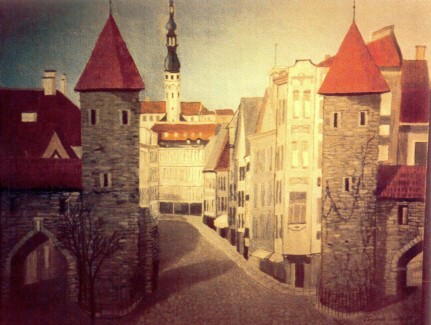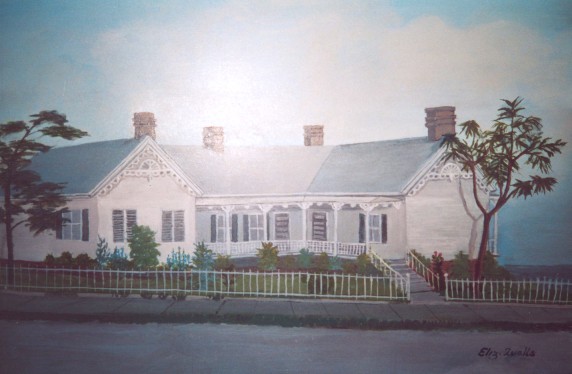|
The Hawkins family owned and operated a
dairy farm near Knoxville from which they produced bottled milk that Ben
Hawkins sold and delivered to grocery stores as well as homes all over the
Knoxville area. Along with milk, cream and butter could be bought also.
During the years Ben and Elizabeth Hawkins were raising their family on
the dairy farm, a young man by the name of B.M. “Buck” Jones came to live
in their home in exchange for helping out with the dairy.
Buck was not only a hard working young
man, but was also a very gifted artist. It was with his help that
Elizabeth, who from the very earliest years of her life had been
interested in art, learned a great deal about how to mix oil paints and
many other details necessary to produce a good painting. Among the many
ways Buck used his artistic talent was in the printing of what was known
as show cards for large department stores, which advertised special sales,
the designing of posters, and he also did a lot of gold lettering on the
glass of office doors and on windows of office buildings.
|
|
When Elizabeth was around the age of 16,
the Hawkins family moved to Morgan County, where she graduated from high
school in Sunbright. Then in 1938, Ben Hawkins found work at the 7-Up
Bottling plant in Livingston and the family moved here. The soda drinks
were produced in a building that will be remembered as Leslie Brothers Dry
Goods on South Church Street.
After settling in Livingston, Elizabeth
attended college at Tennessee Tech, majoring in Home Economics. It was
during this period in her life that she met and later married Herbert
Qualls, son of Dr. and Mrs. A.B. Qualls Sr. The wedding of Elizabeth
Hawkins to Herbert Qualls took place in the home of her parents on East
Broad Street in Livingston. The tall white framed house stood on the lot
between the Hamilton house that John Mark Windle now has an office in and
the house that is known by most as the Floyd Davis house. An evergreen
tree that grew in the yard of their home still remains today, and is the
only reminder that the house was ever there. It leans forward probably
because it grew too close to the house.
|
|
While attending college, Elizabeth
applied for a job as an engineering draftsman with TVA after seeing an ad
in the newspaper. Quite a bit of time went by after Elizabeth applied for
this position – so much time in fact that she decided someone else had
been chosen for the position. But a representative of TVA came to the
college she was attending and did some investigating into her background,
but waited until she had completed her education, which turned out to be
one whole year, before letting her know she had the job. Her work with TVA
in Chattanooga involved the drawing of maps for the United States Army for
use in overseas maneuvers.
All the employees of TVA involved in this
type work were sworn to secrecy, and were not allowed to discuss what they
did with anyone other than fellow employees. But Elizabeth’s career with
TVA did not turn out to be a very long one due to the fact that her mother
developed cancer. Because Elizabeth was needed to help care for her, she
gave up that position and came home. Cancer took her mother’s life in
1950, around six years after she was diagnosed with the dreaded disease.
The Qualls home, which is only minutes
away from the public square of Livingston, has the deceiving appearance of
being very far out in the country. After visiting their home, and seeing
their surroundings, I quickly understood why Herbert Qualls loved the farm
he and Elizabeth and their children, Herbert Ritchey Jr., Ann Elizabeth,
Clara Louise, and David Edward, shared.
In addition to working on the farm,
Herbert raised horses and beef cattle, and in spite of the chores that
kept him busy, he was also an avid reader. Elizabeth described Herbert as
an especially good father to their children, one whom the children at
times would completely abandon their mother for, especially if he was out
working around the farm. Herbert made sure his children always had lots of
farm animals to raise and care for, and was forever adding to the long
list of animals that shared their farm. There were dogs and cats,
chickens, peacocks, turkeys, miniature mules, a pony, and a jenny, as well
as horses. Herbert taught each one of the children to ride the horses. He
spent a good deal of time with his family, and completely shared with
Elizabeth the responsibilities of being a parent. They were a very
close-knit and caring family. Herbert’s activities outside his family
included membership in the Eastern Star and the Shriners organizations. He
was the recipient of the Scottish Rite award while a member of the
Shriners.
Herbert and Elizabeth have always been
active members and supporters of Livingston First Christian Church
(Disciples of Christ). But his life was tragically cut short when, at the
age of only 57 years, he died in an automobile accident. Only the oldest
of the six grandchildren in the family was born before he died. Even with
the busy life she had as a mother and wife, Elizabeth found time to take
some courses at the local vocational school in mechanical and
architectural drafting. The skills and training she received, in addition
to her previous experience with TVA, helped land her several jobs that
included a position for a mapping company that mapped out this and other
surrounding counties for appraisals and tax records.
She was also employed by Ralph Masters, a
well-known cabinet maker here in Livingston for many years, where she put
on paper architectural drawings of various types of cabinetry. She also
worked at Fixture World, a company that among other things, designed and
built the layouts for fast food restaurants. Overton County librarian was
another position Elizabeth held for 3-1/2 years, and for a period of time,
she was also employed at Cumberland Manufacturing.
During all this time, her love of art
continued, and in 1996, she became a member of the Cumberland Arts
Society, an organization which she still actively participates in today.
The walls of her home display several of her amazingly life-like
paintings.
A picture she did for Agnes Sells – a
native of the Scandinavian country Estonia, near the Baltic Sea – depicts
the main street of Agnes’ hometown, a placed called Tallinn. The painting
is like looking at a very good photograph, making it almost impossible to
believe it has been painted. It is so detailed in every way that it seems
to almost spring to life right before your eyes.
|
|
Another interest Elizabeth enjoys is
collecting old books, but her collection of rocks is one that also needs
to be seen to be appreciated.
She once went on a three-month long trip
to Alaska with some friends, which included doing some fishing, but she
found she couldn’t stop picking up rocks long enough to fish while there.
She keeps her rocks in separate containers and grouped together according
to whatever state she was visiting in when she found them. To me, these
very unusual specimens looked like something that should be on display in
a museum.
The peacefulness of their home is
something I felt instantly upon arriving there. The Tasha Tudor book I
referred to earlier describes in detail the Tudor home that she refers to
as Corgi Cottage. I found Elizabeth’s home very similar. Among the
furnishings are many family antiques such as a wonderful old corner
cupboard that stands proudly in a corner of the dining room, along with a
beautiful ornate organ that was bought for Elizabeth by her father.
A picture painted by Elizabeth’s
great-grandfather Smith hangs on the wall of the dining room. Could it be
that the artistic talent Elizabeth has was handed down from him? Elizabeth
said she likes to think so.
|
|
In her kitchen is a small wood cook stove
that she still uses as a source of heat. She says it helps to take the
chill off on cold, damp days. The wonderful old wooden floors of her home,
as well as beautiful chestnut trim around the window frames, has to be
seen to be appreciated. Beautiful china and crystal pieces are displayed
on an antique buffet in the dining room, but probably the most evident
thing in the home was the warmth and inviting atmosphere it offers along
with the history the house contains. It was definitely a place I felt I
could move into tomorrow and be perfectly content there.
Another similarity I found when comparing
Tasha Tudor and Elizabeth was that they are both such very gentle, kind,
and caring individuals. Although Tasha Tudor is a painfully shy person and
Elizabeth isn’t, they each share a love for painting and for living a
simple life that doesn’t include every single modern convenience mankind
has to offer. The love of being outdoors and being content with the simple
things life has to offer are definitely other ways in which they are
similar.
Upon entering Elizabeth’s dining room the
day we visited, the table held a homemade angel food cake she had baked
especially for our visit. Another quality she and Tasha Tudor share which
is to always make visitors feel welcome with something made by hand from
the oven.
I want to go back someday soon and walk
in the fields and woods near Elizabeth’s home to experience the peace and
tranquility that abounds there, and to maybe catch a glimpse of any
wildflowers that might grow there.
It’s the simple things in life that
count, and especially now when we are faced on a daily basis with terrible
news about our country’s involvement in another war, and with all the
detailed media coverage that gives the impression that we’re sitting in
the grandstands watching as the war proceeds, it’s good to know that in
spite of what’s going on in our world, the peacefulness Elizabeth’s home
and farm offers can still be found, enjoyed, and appreciated.
Back to
Josephine's Journal
|
